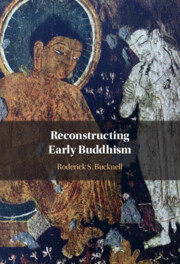Reconstructing Early Buddhism
Buddhist origins and discussion of the Buddha's teachings are amongst the most controversial and contested areas in the field. This bold and authoritative book tackles head-on some of the key questions regarding early Buddhism and its primary canon of precepts. Noting that the earliest texts in Pali, Sanskrit and Chinese belong to different Buddhist schools, Roderick S. Bucknell addresses the development of these writings during the period of oral transmission between the Buddha's death and their initial redaction in the first century BCE. A meticulous comparative analysis reveals the likely original path of meditative practice applied and taught by Gautama. Fresh perspectives now emerge on both the Buddha himself and his Enlightenment. Drawing on his own years of meditative experience as a Buddhist monk, the author offers here remarkable new interpretations of advanced practices of meditation, as well as of Buddhism itself. It is a landmark work in Buddhist Studies.
- Exciting: brings bold and potentially game-changing new perspectives to the study of early Buddhism and to the teachings of its founder
- Relevant: uses expert comparative analysis of the earliest Buddhist texts to reveal the path of meditative practice that the Buddha most probably followed to achieve Enlightenment
- Revolutionary: brings fresh understandings to the historical Buddha – Gautama – and to the contested context of how Buddhism as a religion came into being
Reviews & endorsements
'This book proposes a radical and new understanding of the Buddha's path to awakening (based on a detailed analysis of the earliest textual sources available to us) that will undoubtedly prove provocative and controversial. It will certainly generate much discussion in scholarly circles, within Buddhist communities, and among those interested in understanding the Buddha's teaching and engaging in its practice.' Mark Allon, University of Sydney
'This book is the culmination of fifty years of Roderick Bucknell's Buddhist Studies scholarship, in which he has explored issues in the nature of the path of practice in early Buddhism, especially by comparing a range of parallel texts in Pali and Chinese. The work is clear, informative, well written and well referenced. It contains illuminating analyses of details of the Buddhist path – and of how they relate together, and evolved in different forms – in the first few centuries of Buddhism. It is thought provoking and thus includes controversial aspects with which other scholars may not agree. It will prompt deeper thought on the nature of the path of Buddhist practice, and be of great interest both to scholars of Buddhist Studies and Buddhist meditators.' Peter Harvey, University of Sunderland
‘This excellent book sheds fresh light on the early Buddhist tradition.’ Huỳnh Cao Nhựt Quang, Religious Studies Review
Product details
October 2022Hardback
9781009236522
320 pages
232 × 158 × 23 mm
0.6kg
Available
Table of Contents
- Part I. Background and Context:
- 1. Introducing the project
- 2. The Saṅgha and the oral transmission
- 3. Scriptural sources
- Part II. The Path:
- 4. The stepwise training
- 5. Derivative accounts of the path
- 6. The eightfold path
- Part III. The Practice:
- 7. Mindfulness
- 8. Concentration
- 9. The three knowledges
- Part IV. In Conclusion:
- 10. Summary and implications.



